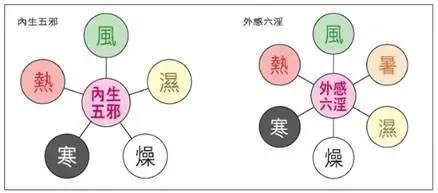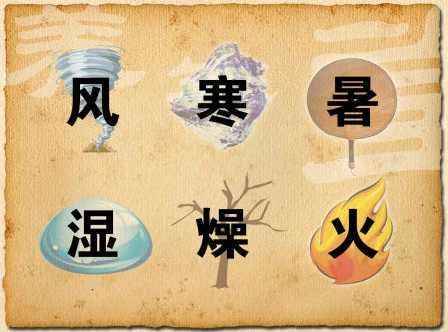Summary of TCM Courses
01
All Courses by Ni Haixia
02
Comprehensive TCM Treatments for Common Diseases
03
Focused Study on TCM Topics
04
Online Reading of TCM Learning Books

The so-called Six Excesses (Liu Yin) refer to the six types of external pathogenic factors: Wind (Feng), Cold (Han), Heat (Shu), Dampness (Shi), Dryness (Zao), and Fire (Huo). The changes in Yin and Yang, the alternation of Cold and Heat, and the variations in climate all follow certain patterns and limits. When climatic changes are abnormal, leading to excessive or insufficient Six Qi, or when these Qi appear out of season, or when climate changes occur too abruptly, surpassing certain limits, the body may fail to adapt, resulting in the onset of disease. Thus, the Six Qi transform from being harmless to harmful, becoming pathogenic factors.


In general, the characteristics of diseases caused by the Six Excesses include the following aspects:
External Pathogenicity
External Pathogenicity: The Six Excesses often invade the surface of the body or enter through the mouth and nose, hence they are also referred to as “external pathogenic Six Excesses.” The diseases caused are collectively known as external diseases.
Seasonality
Seasonality: Diseases caused by the Six Excesses often have distinct seasonal patterns. For example, Wind diseases are more common in spring, Heat diseases in summer, Damp diseases in late summer, Dry diseases in autumn, and Cold diseases in winter. However, multiple pathogenic factors can occur in a single season.
Regionality
Regionality: The diseases caused by the Six Excesses are often closely related to the living environment. For instance, Cold and Dry diseases are more prevalent in the northwest plateau regions, while Damp and Warm diseases are more common in the southeastern coastal areas.
Combination
Combination: The Six Excesses can invade the body individually, such as Cold causing diarrhea, or they can combine to invade the body simultaneously, leading to diseases like Wind-Heat colds, Cold-Damp spleen disorders, and Wind-Cold-Damp bi syndrome.
Transformation
Transformation: Although each of the Six Excesses has its own characteristics, they are not isolated; they can influence each other and under certain conditions, their pathological nature can transform. For example, Cold can become Heat due to stagnation, prolonged Damp-Heat can transform into Dryness harming Yin, and all Six Excesses can transform into Fire due to Heat. The reasons for transformation include individual constitution differences and improper treatment.
Environmental Influence
Environmental Influence: The diseases caused by the Six Excesses are closely related to the environment, such as prolonged exposure to damp environments leading to Damp pathogenic diseases, or high-temperature work environments leading to Dry or Fire pathogenic diseases.
The specific characteristics of each excess are as follows:
1. Wind Pathogen
(1) Wind is a Yang pathogen, characterized by its ability to disperse and invade Yang positions.
“Those harmed by Wind are first affected above.”
(2) Wind moves quickly and changes frequently.
(3) Wind is proactive.
“When Wind prevails, movement occurs.”
(4) Wind is the leader of all diseases.
“Among the Six Qi, only Wind can combine with all five Qi. If combined with Cold, it is called Wind-Cold; with Heat, it is called Heat-Wind; with Damp, it is called Wind-Damp; with Dryness, it is called Wind-Dry; with Fire, it is called Wind-Fire. This is because Wind can stir these five Qi and harm people, hence it is called the leader of all diseases. The other five Qi cannot fully combine with each other; for instance, Cold cannot combine with Heat or Fire, Heat cannot combine with Cold, Damp cannot combine with Dryness, Dryness cannot combine with Damp, and Fire cannot combine with Cold. From this, it can be seen that many diseases arise from Wind.”
2. Cold Pathogen
(1) Cold is a Yin pathogen, which easily harms Yang Qi.
“When Yin prevails, Yang becomes ill.”
(2) Cold causes stagnation and is associated with pain.
“When Cold enters the meridians, it causes stagnation; if it lingers outside the pulse, it leads to blood deficiency; if it lingers inside the pulse, it causes Qi obstruction, resulting in sudden pain.”
(3) Cold causes contraction.
“Cold causes Qi to contract.”
3. Heat Pathogen
(1) Heat is a Yang pathogen, characterized by its heat and inflammation.
(2) Heat disperses and disturbs the spirit, damaging fluids and depleting Qi.
“When it is intense, the pores open, the Ying and Wei Qi communicate, and sweating occurs, leading to Qi depletion.”
(3) Heat often carries Dampness.
4. Damp Pathogen
(1) Dampness is a Yin pathogen, which easily obstructs Qi mechanisms and harms Yang Qi.
It easily harms Spleen Yang; “When Dampness prevails, it leads to diarrhea; if severe, it causes water retention and swelling.”
(2) Dampness is heavy and turbid.
(3) Dampness is sticky and diffusive.
(4) Dampness tends to descend and easily invades Yin positions.
“When Yang is affected by Wind, Yin is affected by Damp; those harmed by Wind are first affected above, while those harmed by Damp are first affected below.”
5. Dryness Pathogen
(1) Dryness is characterized by dryness and easily harms body fluids.
“When Dryness prevails, it causes dryness; all dryness leads to depletion, cracking, and peeling, which are all due to Dryness.”
(2) Dryness easily harms the lungs.
6. Fire Pathogen
(1) Fire is a Yang pathogen, characterized by its inflammatory nature.
(2) Fire easily disturbs the spirit.
(3) Fire easily depletes fluids and Qi.
“Intense Fire consumes Qi.”
(4) Fire easily generates Wind and stirs blood.
“Extreme Heat generates Wind.”
(5) Fire easily causes swelling and ulcers.
“Abscesses and sores are primarily caused by Fire toxicity.”

In TCM, in addition to identifying the Six Excesses as disease causes, the characteristics of the Six Qi are also linked to the symptoms of the diseases, forming disease names such as Wind Syndrome, Cold Syndrome, Damp Syndrome, Fire Syndrome, Dry Syndrome, etc. These syndromes have a certain causal relationship with the Six Excesses.
For example, Wind invasion can lead to external Wind-Cold, but some conditions may not be classified as external diseases yet exhibit similar symptoms to Wind, Cold, Damp, Dryness, and Fire, such as Wind rash, which typically presents with rapid onset, quick resolution, and itching, resembling the characteristic of Wind’s “ability to move and change frequently.” It is generally believed to be caused by Wind, but due to the dysfunction of Yin, Yang, Qi, and Blood in the organs, certain similar properties and symptom characteristics to the external Six Excesses can also arise.
In TCM, to distinguish from external Six Excesses, they are referred to as internal Wind, internal Cold, internal Dryness, internal Fire, internal Dampness, etc. The following discussion primarily focuses on the external Six Excesses, including the characteristics of pathogenic factors and the related syndromes.
For neck, shoulder, waist, and leg pain, apply Hei Bai Tong (Black Atractylodes) patches.

